

 |
 |
|
 |
 |
This web page has audio clips - just click on the icon (like the one to the left) and you can hear Prof. Richardson's voice adding additional information to topics on the page. |  |
turn on your speakers to hear audio clips |
| . | This page
used in the following courses taught by Prof. Richardson
.
|
.
| LEARNING
OBJECTIVES |
After reading
this unit, viewing the videos, and listening to the lecture in class, students
will have information about:
o The formal definition
of "Viral Marketing"
|
| Viral
Marketing a def'n |
"Viral marketing
refers to the marketing techniques that seek to exploit pre-existing
social networks to produce exponential increases in brand awareness, through
viral processes similar to the spread of an epidemic. It is word-of-mouth
delivered
and enhanced online; it harnesses the network effect of the Internet and
can be very useful in reaching a large number of people rapidly."
~ http://en.wikipedia.org/wiki/Viral_marketing |
| Viral
Marketing a def'n WTGR |
Word-of-mouth
marketing has been around for many decades before the internet, but like
anything - technology can enhance capabilities to allow a simple situation
to become more intense.
Viral Marketing is a term which is used to describe how companies use the technologies of the Information Age
WTGR |
| Viral
Marketing a def'n KHNK |
Viral
Marketing focuses on content people would feel compelled to pass around,
and as a result, "things that tend to spread in a truly viral way are things
that most clients wouldn't necessarily want their brand to be associated
with, says Bruce Sinclair, a national creative director from Tribal
DDB Canada (a media company that plans, builds and sells client brands
by generating brand demand). Sinclair also goes on to say, "You can create
content that has a chance of being shared, but unless you are looking
at it for the sheer sake of entertainment and creative content, it is very
difficult to do work that is truly viral."
Viral marketing depends on a high pass-along rate from person to person. If a large percentage of recipients forward something to a large number of friends, the overall growth snowballs very quickly. If the pass-along numbers get too low, the overall growth quickly fizzles.*** |
| As
a result of being quoted in the October 31st 2007 CP story on Ad-blocking
software, Richardson's quotes ran in a number of newspapers (online
and printed) throughout North America, including Yahoo.ca and msn.com
see article at witiger.com/ecommerce/articleCPinterview.jpg |
| Things
that spread Virally through YouTube
2008 |
Natural - not
faked
One of the things that makes a video likely to "go viral" is when it appears to be something that was not faked and something that actually happened in a natural, un-contrived way. Companies selling "branded" products and services love it when customers create such videos because it leads to people having a "good feeling" about the product or service and contributes to brand loyalty - the example below of a flight attendant is one of the early examples of a video that "went viral" this way.
|
v
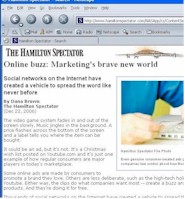 |
In the 3rd week of December
2006, Richardson was interviewed by the Hamilton Spectator about the circumstances
of viral marketing.
Click on the scan to the left to read the article. |
| Circumstances
leading people to want to try Viral Marketing |
Before
delving into the details of Viral Marketing, it might be useful to step
back and have a sort discussion about what are some of the circumstances
that cause this form of marketing to be of such strong interest to marketers
in the later half of the first decade of Y2K.
I was thinking about how viral marketing is probably a way more effective way to create brand awareness and to get the word out to consumers. This is especially true now that there are new pieces of technologies available, which are eliminating the need to watch commercials and ads. I mentioned in class how I personally have a PVR system (Personal Video Recorder) at home that allows me to pre-record my TV shows and also allows me to pause, rewind and fast-forward through-out the shows. This way, I choose not to watch any commercials. I
came across an interesting article
"I'm not so sure that the whole issue really is one of commercial avoidance," Shaw said. "It really is a matter of convenience--so you don't miss your favourite show...." Sidra concludes
|
| KEY
POINTS
Pass-Along Rate |
|
 |
| Word
of mouth marketing Before the Internet |
Dr.
A. Coskun Samli is a research professor of marketing and international
business at University of North Florida. Author of more than 250 articles
and 13 books, Dr. Samli is widely quoted as having done a study 3 decades
ago in which the research showed that 40% of the consumers to an average
retail situation, are attracted to a product based upon recommendations
from friends.
 |
| The
History behind Viral Marketing |
There was once a television
commercial aired about a woman who loved her shampoo so much she went on
and told two friends. Based on the convincing recommendation, the woman's
friends who tried the shampoo were so satisfied with the product that they
were compelled to go on and tell two more friends and so on.
|
| The
History behind Viral Marketing  |
Viral marketing was a term
originally coined by venture capitalist Steve Jurvetson to describe the
unique referral-marketing program created by Hotmail, one of the first
free e-mail services.
Steve Jurvetson (bio) is [2005] the Managing Director of 'Draper Fisher Jurvetson' www.dfj.com (a premier venture capital firm). This firm has created a global network of affiliated venture funds with over $3 billion in capital commitments and offices in the major technology centers around the world. How Jurvetson helped Hotmail spread using Viral Marketing: Hotmail would include a promotional line for its free e-mail services at the bottom of every message. Users of Hotmail were automatically promoting the free service to their friends and colleagues every time they sent an e-mail message. The free service spread like a virus, and Hotmail reportedly received 12 million new subscribers within 18 months of its launch from this simple technique!!! Draper Fisher Jurvetson reported that Hotmail spent less than $500,000 on marketing, advertising and promotion during this period while its nearest competitor, Juno, spent $20 million for a fraction of the subscribers. Thus, it was originally Hotmail, who developed the concept of viral marketing. |
| The
origins of Viral Marketing in the context of the Internet |
Martin says
The article describes how the "Organic Trade Association" asked a marketing agency to design a short film for their message of food and agricultural issues in a lighthearted way. The result was a Star Wars spoof called "Store Wars: The Organic Rebellion" that has been viewed by 10 million people within 4 months due to viral marketing. There's even an incredible quote from the communications director of the OTA stating "It was amazing how quickly it went around the world...I got email from people who wanted to translate the work into Japanese, Portuguese, German, Polish and Spanish within 48 hours of the films launch." Amazing stuff. I'll be sure to bring the article to class ... I think it makes a great success story for the power of word of e-mouth." |
| The
origins of Viral Marketing - Internet based |
The story Martin is referring
to was written by Tessa Wegert of the Globe and Mail and titled
"Advertisers get creative in bid to infect the Internet" Wegert explains
Holly Givens, communications
director with the Massachusetts-based OTA says,
The Globe & Mail Permissions Coordinator told TR by phone Oct 31st, 2005 that the Globe does not give digital rights for reusing articles but they will allow quotes of up to 25 words. |
| The
origins of Viral Marketing |
youtube.com/watch?v=hVrIyEu6h_E (link worked 2018 Feb) |

There
are 6 main types of viral messages:
(with
notes from http://en.wikipedia.org/wiki/Viral_marketing
)
| How
to do
Viral Marketing |
There are
6 main types of viral messages:
1.
Pass-along
2. Incentivised viral 3. Undercover 4. "Edgy gossip/Buzz Marketing" 5. Anonymous matching 6. Guerrilla Marketing |
| How
to do
Viral Marketing |
1.
Pass-along
A message at the bottom of an e-mail that prompts the reader to pass it along (eg. chain letters). The success of this method depends on how interesting or exciting or believable the message is KHNK |
| How
to do
Viral Marketing |
2.
Incentivised viral
Offering rewards for providing someone's address. This can dramatically increase referrals. However, this is most effective when the offer requires another person to take action. Most online contests offer more chances of winning for each referral given; but when the referral must also participate in order for the first person to obtain that extra chance of winning, the chance that the referral participates is much higher. KHNK |
| How
to do
Viral Marketing |
3.
Undercover AKA Stealth Marketing
A viral message presented as a cool or unusual page, activity or piece of news, without obvious incitements to link or pass-along. Particular effort is made to make the discovery of the item seem spontaneous and informal, to encourage natural memetic behaviour. Outside world "clues", such as graffiti appearing in cities with key viral words, is often used to direct people to search out the presented "mystery". Because of the large amount of unusual and entertaining content on the internet, this can be the hardest type of viral to spot, especially as companies try to imitate the style and content of amateur websites and authentic underground movements. KHNK |
| How
to do
Viral Marketing |
3.
Undercover Version 2
Sometimes
a viral message is not secret or undercover, it is simple the way it gets
passed innocently to other people in a quiet way.
|

pic supplied by Tina |
3.
Undercover Version 2
Tina
wrote
An effective way Rogers Wireless has incorporated viral marketing is through self-replicating e-mail signatures on smartphone handheld devices. For every message sent out on a default handheld under Rogers Wireless, signatures are automatically appended to e-mails the user sends. It has "Sent from my BlackBerry device on the Rogers Wireless Network" at the end of all outgoing messages. By sending messages, users are unknowingly (or at least not on purpose) passing on a marketing message to others creating potential for the message's exposure and influence. This is an effective strategy for Rogers to create brand awareness and other marketing objectives such as increasing their BlackBerry product sales. Getting the word out to customers this way interests users on the receiver's end and prompts them to consider getting a BlackBerry themselves. In addition, Roger's operators no longer need to spend so much time marketing the the BlackBerry smartphones because the messages market themselves. Witiger
adds
|
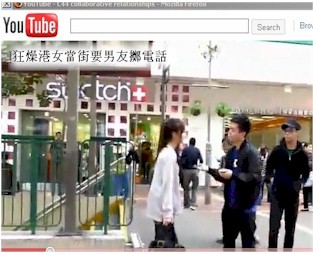
youtube.com/watch?v=2ydFeV3i45A&feature=related (link dead) |
3.
Undercover Version 3
Make
it seem like a real event, but it ends up talking about a branded consumer
product
When I was studying the topic of viral marketing for the test, I thought of a link that had been forwarded wildly in Facebook last month. In the link, there is a Hong Kong couple and they are arguing since the guy is playing his phone and did not hold the girl's hand. The girl was so angry and kept complaining that her boyfriend only cared about his cellphone and ignored her. The girl did not accept any explanation and even cried in the street. The video caught pedestrain's attention and many of them stop around the couple and listen to their argument. |
Gloria
says
However, after the second part is being published in the video, some viewers thought they were being cheated by Samsung and they were not please by the way they promote their products. It may end up resulting in a negative influence to Samsung as potential users will not want to use the products anymore. The first part of the story can be viewed in the link above. Too bad they do not have English subtitle (probably becasue they want to make it more like taken by an amateur). The whole idea of it is basically the couples are arguing in the street. The
second part of story, which shows it is actually an ad. From 0.30
to the end, it becomes a normal ad. we can see in television.
|
| WTGR replies
Gloria, thanks for sharing, yes, this is an interesting way to create a "pass along" piece of media - but I wonder if it matters if some people get annoyed at being tricked - in the end, it is still publicity, and sometimes even bad publicity can still work - rememberm the whole point is to create awareness about the particular feature on the new phone, and if that causes people to but it, then who cares if they dislike the viral media that got them to that purchase decision - kinda cynical way of looking at it, but that might what they were thinking. |
| How
to do
Viral Marketing |
4.
"Edgy gossip/Buzz Marketing"
Ads or messages that create controversy by challenging the borders of taste or appropriateness. Discussion of the resulting controversy can be considered to generate buzz and word of mouth advertising. Prior to releasing a movie, some Hollywood movie stars get married, get divorced, or get arrested, or become involved in some controversy that directs conversational attention them. An example is the publicity campaign about the dubious love affair between Tom Cruise and Katie Holmes that came out just before each of them released a movie, or the controversy over who would be named the next James Bond. KHNK |
 |
March and April
2013 I had several students mention the videos that had gone viral regarding
the Volkswagen 2013 Superbowl Commercial.
Knowing a little bit about Jamaican culture, I offer these additional videos for your interest pic to the left is me (WTGR) in Montego Bay with the original Jamaican Bobsled made famous in the 1993 movie Cool Runnings. |
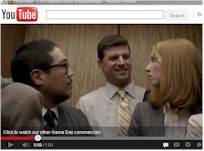 |
This is a screen
capture on which you can click to see the original VW Superbowl ad featuring
the white guy with the Jamaican accent.
youtube.com/watch?v=WCK0WsH0wKE (link good 2014 Oct 14) When it came out some people
criticized VW for being racist
|
 |
Following widespread
media coverage of the video
youtube.com/watch?NR=1&v=W0UxmgMwcAI&feature=fvwp many black Jamaicans commented that it was not racist at all - cause there are in fact many white people living in Jamaica. Spoof Video youtube.com/watch?v=7dGSKQnMH4g (link good 2014 Oct 14) . The video to the left is a white Jamaican who has had a YouTube channel up since 2006 and posts many comments about Jamaican culture - and he commented about the VW video.. |
| "Edgy gossip/Buzz Marketing" | So if the objective of Edgy gossip / Buzz marketing is to get eveyone talking about your product, VW certainly achieved that, especially since hundreds of TV news channels insisted on showing segments of the clip which drove up views on the original clip to more than 10 million, as well as launching many video comments and even a parody - which is the ultimate compliment to how well you created a buzz. |
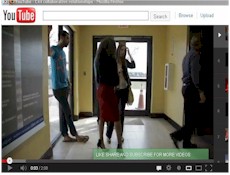 |
One of the best
indicators of how successful a buzz marketing video can be, is if it encourages
people to make parody videos, like the Harlem Shake.
see a "made in Jamaica" parody
produced in reaction to the original.
VW must love this cause it is, in a sense, the public making their own commercials |
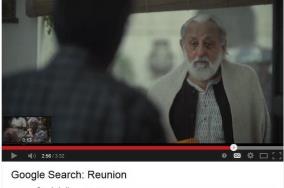
Partition of India and Pakistan http://en.wikipedia.org/wiki/Partition_of_India |
Sometimes sponsors
of a "Viral Video" have a more noble purpose than simply frivolous entertainment.
There are a number of viral videos on the web that have a message or comment, (direct or indirect) about the human condition and our relationships with others. Google's video about two old men reunited by a grand daughter (who uses Google search and Google maps to bring them together) has been a hit in the Desi community in Canada and globally - this video had more than 10 million hits by the end of 2013. It was launched in mid-Nov 2013. |
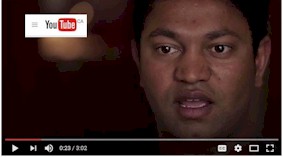 |
Google's video
about a poor boy (Saroo
Brierley) in India who ends up being adopted and raised by a family
in Australia. Saroo, when older, uses Google search and Google maps to
find his family - the story ends up as a Hollywood
film starring Nicole Kidman and Dev
Patel (who played the central character in Slumdog Millionaire, also
The Best Exotic Marigold Hotel)
added by MRK460 student Scarlet Yung 2017Feb15 |
| . | Coke's 2014
Superbowl commercial
youtube.com/watch?v=D4BC8zUfNhU (link good 2018 feb) . Coke, like several giant sized American companies selling a globally branded comsumer product, is approaching the status of transnational corporation in which their product is seen to be beyond national boundaries - many coke commercials over the years have shown people in other countries drinking Coke-- yet, at the same time, Coke "represents" one of the strong identifiers of "American culture". In the 2014 Superbowl commercial what created a "Buzz" was the negative reaction of racist Americans who protested "America the beautiful" sung in a language other than English. CCT322 student Fatima S.
at UofT Mississauga in early Feb 2014 said
Fatima provided the tumlr
link
WTGR "I agree Fatima, it is sad, and it remains to be seen how Coke will react, will they take the high road and see their product as a global brand and continue to show "world peace and harmony" themes, or will they be frightened about the backlash in their home country and pull the ad." WTGR showed this in several classes in Feb 2014 |
"Edgy gossip/Buzz Marketing"
"Ads or messages that create
controversy by challenging the borders of taste" c
 |
A good example of a situation that "created controversy" and was strongly accused of "challenging the borders of taste" was the proposal by |
| Oh, and yes the group got an "A" on the project - partly because the prof (WTGR) was impressed that they came up with this kewl concept, and also out of respect they took the time to actually go downtown and do it - this is something you might expect from a real "trendy restaurant" - but this was just a bunch of students carrying out an experiment for a class project - you gotta respect that enthusiasm. |
| How
to do
Viral Marketing |
5.
Anonymous matching
This service requires each user to create a confidential list of friends and acquaintances they are interested in dating. A match only occurs if the object of their affection reciprocates by logging in and placing them on their own secret list; thus, each user has an incentive to get their crushes to visit the site. Most of these services allow users to email recipients anonymous messages informing them that an undisclosed person has a crush on them. On eCRUSH, one system using this methodology, 20% of the email recipients start accounts of their own. A Business 2.0 article noted, "eCrush is intrinsically viral – hopeful romantics become eCrush marketers as they try to find out if their crushes return their ardor" KHNK |
| How
to do
Viral Marketing  |
6.
Guerrilla Marketing
witiger.com/ecommerce/viralmarketing-guerilla-marketing.htm As a military concept, guerrilla forces are used by an "aggressor" when the opposing force is overwhelming large. The guerrillas don't try to match the opposing force size-for-size, rather they use "guerilla tactics" such as small groups of attackers targeting weak points in the opposing force, such as attacking at night on an exposed perimeter, or attacking when the opposing force is restricted by geography from moving as a large mass - ie. in mountainous terrain or a narrow river valley. Guerillas use different weapons, strategies and tactics to make up for having a more limited access to resources. For example, instead of having several soldiers riding in an expensive armoured HUMVEE, they have one man with a LAWs rocket or an RPG, which can "take out" a lightly armoured vehicle. So the principle is that you have less people and less money for equipment and resources, but by employing particular strategies and tactics, you can have a significant "effect". The pic to the left shows a soldier in Operation "Desert Shield" using a Light Anti-tank Weapon (LAW) |
| Advantages |  |
|
Disadvantages |  |
 |
The
advantages of viral marketing are low costs, great reach, high credibility,
high efficiency and the possibility of continuous campaign adjustments.
The downfalls of viral marketing include the extent of the reach of failed
campaigns, the lack of control, risks that the viral message is perceived
as spam and the limited possibility for segmentation.
o Cheap and low cost (there's no printing involved!)
|
 |
Pitfalls
- things to avoid
o Brand Dilution o Association with unknown groups o Avoid making purely financial-based offer o Large-scale spam issues Brand
Dilution
Association
with unknown groups
Avoid
making purely financial-based offer
Spam
threats
|
 |
Pitfalls
- things to avoid
One
of the things you definitely want to avoid is people being so repulsed
at the message (either the words are sick or the images are disgusting)
that they do not pass it on, and in fact consider the topic negatively
in the wrong way.
|
| . |
Extremes
of Viral Marketing
|
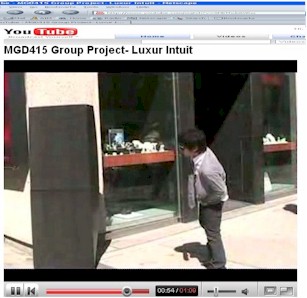
Sol explains "Basically, we set up a black presentation board to look like a booth at a corner of Bloor st. and we left it there to film from across the street. People randomly walked by on the street and they started to stare at the booth and we even heard people saying "what's this?" and they were questioning to each other about the booth. |
Viral Marketing
- an experiment set up by some University of Toronto (UTM) students in the MGD415 class in March 2008 - big thanks to Sol L. for
setting this up with other group members Betty, Marg and Gord
|
| It was originally filmed for our group project, however it happened to be a viral marketing experiment when we realized people on the streets were talking about it. It is just a simple video but we believe the clip defines viral marketing." |
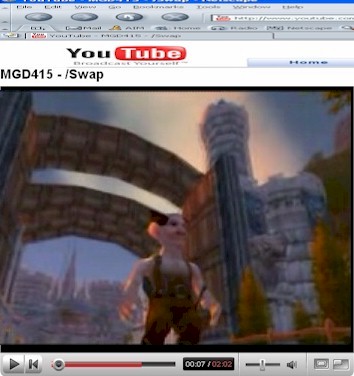 |
Viral Marketing
- a video created by some University of Toronto (UTM) students in the MGD415 class in March 2008 for the purpose of explaining how their company was providing services to the MMORPG industry - the video was done by taking existing components of an interactive video game and adding in characters from the class and their presentation for the purpose of having something they could use in the marketing of their service - which was targeted for people creating MMORPG. The fact that they named one of the characters in the game Witiger (an ugly little troll type), was not held against them! |
| "Through a machinima presentation, we are able to develop relevant media that embodies our target markets personalities and practices, while simultaneously communicating an image of an approachable, light-hearted corporate entity. In doing so, our expectation is that pertinent viewers will actively share such videos with others in the gaming community, be it for humorous one liners or their relatable material, thusly, creating a situation palpable for buzz-based viral marketing with a high potential for brand exploration. " |
WTGR explains
| When
you watch the video, you'll see some characters doing some things that
have been controlled by the students. Ian uses the term "Machinima"
Wikipedia describes Machinima by saying it "is a collection of associated production techniques whereby computer-generated imagery (CGI) is rendered using real-time, interactive 3-D engines, such as those of games" MMORPG - means Massively multiplayer online role-playing game (MMORPG) and is a genre of online computer role-playing games (CRPGs) in which a large number of players interact with one another in a virtual world. |
| Companies
specializing in Viral Marketing |
GFK
NOP, a market research firm, has specialized in advising clients about
word-of-mouth marketing and has done studies that show word-of-mouth
comments by a friend carry twice as much weight in making a purchase decision
compared to any information from mass advertising.
"Face-to-Face Still Number
One Way Consumers Make Recommendations According to NOP World Study"
NOP World announced in April 2005 the results of a national study uncovering where the "roots" of grassroots marketing lie. "The findings reveal face-to-face remains the strongest medium for spreading word-of-mouth" "When asked how they make
recommendations, 80% of consumers say they make them in-person, followed
by 68% who say they make them over the telephone. the study found that
less than 40% of consumers use e-mail to make recommendations to others,
including via personal e-mail (37%), by e-mail forwarding (32%) or through
mass e-mails (12%)."
GFK stands for Growth
From Knowledge. GfK has home offices in Nuremberg, Germany,
The GfK Group is among the top-three market research organizations in
|
| Companies
specializing in Viral Marketing |
Matchstick was hired by Ford Canada to help launch the Zephyr line of cars through creating situations were people could drive one of the cars for free if they agreed to talk about it with their friends. |
 |
|
| Famous
examples of Viral Marketing mixed with web-based content |
Terry
Tate, Office Linebaker - a series of TV commercials sponsored by Reebok,
which were very popular, and encouraged people to go to the reebok.com
site to see more of the commercials online
The point being, it is great that people think your commercial is kewl, but it has to have a relation to buying the product otherwise you're just spending money on entertainment. Terry Tate's real name is Lester Speight, ( en.wikipedia.org/wiki/Lester_Speight) a former pro football linebaker who now has his own site at www.mightyrasta.com/ |
| Examples of Viral Marketing mixed with web-based content |
Hello Professor Richardson,... I thought I would share this article I found on viral marketing... the article shows how viral marketing is being used as an effective business strategy. Particularly, I found this article that states the motion picture industry, Hollywood to be exact, has found a new way to market their movie trailers and DVD ads by posting these mini web videos on popular sites such as YouTube. This way they are exposing their key demographics of teenagers and young adults, who frequently utilize these entertainment venues, to their range of product offerings. Paramount Pictures is one example that has used YouTube to now post at least three trailers per month. In this article http://news.zdnet.com/2100-9588_22-6091540.htmlit clearly explains that this is a strong marketing strategy in order to get the word out. “The move to promote DVDs through viral video sites is part of an overall shift to Web marketing by the studios.” Nicole concludes
|
 |
Click on the
girl's faces to hear
the full clip in English and Mandarin - it contains some funny and
amusing comments about earning class participations marks and their comments
also about the course
As Betty explained in an
email March 30th, 2008
|
 |
Click to the left to read
the English / Chinese (Mandarin) script
of the audio clip
(but do this after you listen
to the audio clip)
|
| Things
that spread Virally through YouTube
Politics
2008 |
YouTube story about the original
"I got a crush on Obama" and origins of Obama Girl vs. Guliani Girl"
Washington Post commentary
on the Viral Marketing aspects
|
| ETHICS
of Viral Marketing |
Gary
Ruskin of Commercial Alert www.commercialalert.org
has been quoted as saying "buzz marketing perpetuates large-scale deception
upon consumers when people recruited to promote products by word of mouth
don't disclose that fact"
commercialalert.orgdiscusses
Manipulating Teens
www.tremor.com, a Procter & Gamble Web site that has enlisted a quarter-million teenagers as "word-of-mouth" marketers. "Tremor is part of a burgeoning trend in marketing: using "real people" to create a buzz for products and services. But teens who join the Tremor Crew aren't required to acknowledge the gig to anybody - even to their own parents." says Jeff Gelles of the Philadelphia Inquirer "Tremor and other such marketers are under scrutiny because of a complaint by Commercial Alert,...some of their tactics may violate laws against deceptive advertising. Commercial Alert has called on the Federal Trade Commission to investigate such practices." says Gelles Gelles says "Tremor offers a marketer's dream: a large pool of well-connected teenagers, influential among their peers, who will talk up the products and services of its clients." Richardson received email from Ruskin of Commercialalert.org November 14th 2005 giving permission to link and quote. Copies of emails are in the permissions binder. |
| KHNK | This
page (http://www.witiger.com/ecommerce/viralmarketing.htm) was originally
created by KHNK in 2005
Pronounced "Kink", this dynamic team, was made up of two students Kevin Ho and Naila Khan who were in MGTD06 at University of Toronto in the Sept-Dec 2005 session. Kevin and Naila researched some of the main points in this unit, and created the logo at the top of the page. Since 2006, many other students in classes at U of T Scarborough, U of T Mississauga and Seneca College have made contributions to this page - which are shown herein. |
|
|
CONTACT I MAIN PAGE I NEWS GALLERY I E-BIZ SHORTCUTS I INT'L BIZ SHORTCUTS I MKTG&BUSINESS SHORTCUTS I TEACHING SCHEDULE |
| . | |
| MISTAKES ITEXTS USED I IMAGES I RANK IDISCLAIMER I STUDENT CONTRIBUTORS I FORMER STUDENTS I | |
| . |